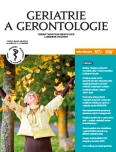New criteria for diagnosis of malnutrition – what do they say?
Authors:
Mgr. Ing. Tereza Vágnerová
Authors‘ workplace:
Geriatrická klinika 1. LF UK a VFN Praha Lůžka včasné rehabilitace iktového centra 1. LF UK a VFN Praha
Published in:
Geriatrie a Gerontologie 2019, 8, č. 1: 20-26
Category:
Review Article
Overview
Correct diagnostics of malnutrition or insufficient nutrition is currently being given increased attention. Adequate intervention tailored to the patient with professionally diagnosed stage and ethology of malnutrition has an undeniable effect on the patient’s successful treatment and overall prognosis. The malnutrition diagnosis, however, is becoming difficult to assess in the current chaos of different criteria and approaches even for experts in the field. The concept of nutrition disorders itself according to the International Classification of Diseases (ICD-10) does not always correspond with modern concept and terminology of malnutrition commonly used in clinical practice and research. It is therefore appropriate to ask - can we correctly identify the patient’s diagnosis? Do we understand what “nutritional” diagnosis we actually determine and why are we deciding for it? The new Global Leadership Initiative on Malnutrition (GLIM) seeks to be the answer to these questions. GLIM brings a strong global consensus of malnutrition classification in clinical practice through a two-step model for malnutrition risk assessment and diagnosis. This is described according to the recommendation below.
Keywords:
malnutrition – nutritional screening – diagnostic criteria – nutrition assessment
Sources
1. Guigoz Y, et al. The Mini Nutritional Assessment (MNA) review of the literature-what does it tell us? Journal of Nutrition Health and Aging 2006; 10(6): 466.
2. Elia M. The cost of malnutrition in England and potential cost savings from nutritional interventions (full report). BAPEN report, 2015.
3. Müller M, et al. CEPTON-Studie: Mangelernährung in Deutschland. Erlangen: Bressler Druck 2007.
4. Freijer K, et al. The economic costs of disease related malnutrition. Clinical nutrition2013; 32(1): 136–141.
5. ÚZIS. Mezinárodní statistická klasifikace nemocí a přidružených zdravotních problémů: MKN-10: desátá revize: aktualizovaná druhá verze k 1. 1. 2009. 2., aktualiz. vyd. Praha: Bomton Agency 2008. Dostupné z: www.uzis.cz/cz/mkn/index.html.
6. Vokurka M, et al. Velký lékařský slovník. 6. vyd. Praha: Maxdorf 2009.
7. Cederholm T, et al. ESPEN guidelines on definitions and terminology of clinical nutrition. Clinical Nutrition 2017; 36(1): 49–64.
8. Singer P, et al. ESPEN guideline on clinical nutrition in the intensive care unit. Clinical Nutrition 2018, 37(5): 1–32.
9. Zadák Z. Výživa v intenzivní péči. 2. vyd. Praha: Grada 2009.
10. Cederholm T, et al. GLIM criteria for the diagnosis of malnutrition – A consensus report from the global clinical nutrition community. Clinical Nutrition 2018; 37(5): 1–9.
11. Winter JE, et al. BMI and all-cause mortality in older adults: a meta-analysis. The American Journal of Clinical Nutrition 2014; 99(4): 875–890.
12. Chernoff R. Geriatric nutrition: the health professional’s handbook. 4. vyd. Burlington, MA: Jones & Bartlett Learning 2014.
13. Cruz-Jentoft AJ. European Working Group on Sarcopenia in Older People: Sarcopenia: European consensus on definition and diagnosis. Report of the European Workign Group on Sarcopenia in Older People. Age Ageing 2010; 39 : 412–423.
14. Topinková E. Sarkopenie, revidovaná evropská diagnostická kritéria 2018. Geri a Gero 2019; 8(1): 14–19.
15. Kondrup J, et al. ESPEN guidelines for nutrition screening 2002. Clinical Nutrition, 2003; 22(4): 415–421.
16. Rubenstein LZ, et al. Screening for undernutrition in geriatric practice: developing the short-form mini-nutritional assessment (MNA-SF). The Journals of Gerontology Series A: Biological Sciences and Medical Sciences 2001; 56(6): 366–372.
17. Stratton RJ, et al. Malnutrition in hospital outpatients and inpatients: prevalence, concurrent validity and ease of use of the ‘malnutrition universal screening tool’(‘MUST’) for adults. British Journal of Nutrition 2004; 92(5): 799–808.
18. Cederholm T, et al. Diagnostic criteria for malnutrition – an ESPEN consensus statement. Clinical Nutrition 2015; 34(3): 335–340.
19. White JV, et al. Consensus statement: Academy of Nutrition and Dietetics and American Society for Parenteral and Enteral Nutrition: characteristics recommended for the identification and documentation of adult malnutrition (undernutrition). Journal of Parenteral and Enteral Nutrition 2012; 36(3): 275–283.
20. Detsky AS, et al. What is subjective global assessment of nutritional status? Journal of Parenteral and Enteral Nutrition 1987; 11(1): 8–13.
21. Evans WJ, et al. Cachexia: a new definition. Clinical Nutrition 2008; 27(6): 793–799.
22. Fouque D, et al. A proposed nomenclature and diagnostic criteria for protein-energy wasting in acute and chronic kidney disease. Kidney International 2008; 73(4): 391–398.
23. Fearon K, et al. Definition and classification of cancer cachexia: an international consensus. The Lancet Oncology 2011; 12(5): 489–495.
24. Jensen GL, et al. International Consensus Guideline Committee: Adult starvation and disease-related malnutrition: a proposal for etiology-based diagnosis in the clinical practice setting from the International Consensus Guideline Committee. JPEN J Parent Enteral Nutr 2010; 34(2): 156–159.
25. Volkert D, et al. ESPEN Guideline on Clinical Nutrition and Hydration in Geriatrics. Clinical Nutrition 2018; 37(3): 1–38.
Labels
Geriatrics General practitioner for adults Orthopaedic prostheticsArticle was published in
Geriatrics and Gerontology

2019 Issue 1
Most read in this issue
- Intravenous administration of hugh doses of vitamin C
- New criteria for diagnosis of malnutrition – what do they say?
- Sarcopenia, revised European diagnostic criteria 2018
- Statin therapy in elderly patients
